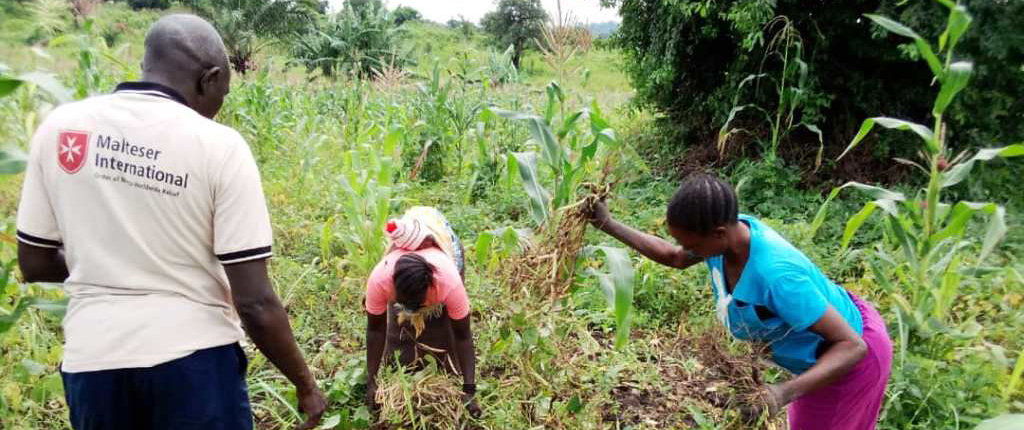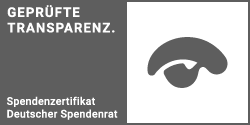
Improved living conditions for South Sudanese refugees and the host population through community-based approaches
Due to ongoing internal conflicts in South Sudan, over 89,000 South Sudanese have fled from their country to seek shelter in the north-eastern parts of the Democratic Republic of Congo. In the province of Ituri, most of the refugees do not stay in camps, but they live within the local communities and find shelter in simple housings or host families, in emergency situations also in schools or churches.
The already difficult food and nutrition situation in the region has further worsened since the arrival of the refugees. In addition, the water supply and hygiene situation in villages, schools and health facilities is often insufficient. This increases the risk for the spread of epidemic diseases. Based on many years of experience in the project region, we aim to sustainably strengthen the living conditions of the South Sudanese refugees and the host community by applying community-based approaches in the sectors of nutrition, health and water, sanitation and hygiene (WASH).
The Democratic Republic of Congo (DRC) is caught in a protracted crisis. Years of favoritism and ongoing conflicts, sometimes with foreign involvement, are amongst the main reasons. The north-eastern province of Ituri is particularly affected by the multiple crises. At the same time, the DR Congo is hosting refugees from South Sudan. Due to ongoing internal conflicts and armed clashes, more than 89,000 refugees have fled from South Sudan to the DRC since 2016. Many of the South Sudanese refugees (around 35,000 people) have settled in the Adi health zone. The Adi health zone is located in the north of the province Ituri, in the triangle of South Sudan-Uganda-DR Congo. In addition to the welcoming attitude towards refugees, Adi is most probably a preferred destination because the area is home to Congolese nationals belonging to the same ethnic group as the South Sudanese refugees, namely the Kaggwa. On arrival, the refugees often live with host families and then integrate into local village structures as independent households. In this out-of-camp context, the refugees have to manage their livelihoods without any support from international or national actors.
The situation in the health zones confronts the host community and the refugees with enormous challenges. The local population is predominantly living self-sufficiently from agriculture and therefore highly dependent on the scarcely available resources. Due to the influx of refugees, the resources are further getting scarce, which could lead to tensions between refugees and the host community. As a result, a large proportion of the refugees and the host community suffers from food insecurity. In the project area, over 10% of the refugee children suffer from acute malnutrition.
The villages and schools have insufficient access to drinking water and sanitary facilities. Many diseases are caused by contaminated drinking water. Due to the high population density in the health zone Adi, an increased risk of epidemic diseases exists. However, the health infrastructure is weak, and water and sanitation facilities are lacking, which means that good hygiene practices and infection prevention measures cannot be respected.
The aim of the project is to sustainably improve the living conditions of the local population and the South Sudanese refugees in the health zone Adi (Ituri Province) as well as adjacent health zones in the areas of nutrition, health and water, sanitation and hygiene (WASH) and to promote social cohesion by equally addressing both groups.
-
Strengthened food and nutrition security (FNS) with a focus on a balanced diet of small-scale farmers (refugees and local community) and reduction of malnutrition among children
- Improved access to treatment for malnutrition and strengthened local capacities to reduce malnutrition
- Reduced risk of spreading epidemic diseases in health care facilities
- Improved health of the refugee and host communities through better hygiene practices as well as improved water and sanitation infrastructure in villages and schools
Food Security:
- Establishment of small-scale farmer groups and training in sustainable farming methods (including seed production)
- Distribution of seeds and agricultural equipment to the small-scale farmer groups
- Construction of home gardens
- Creation of fishponds, including training on their use
- Training for fish marketing
Nutrition:
- Reimbursement of costs to health care facilities which enables them to offer free treatment of acutely malnourished persons
- Support of the local production of therapeutic feeding (Corn-Soy-Blend) to treat acute malnutrition
- Supply of anthropometric equipment and medical drugs for the treatment of malnutrition
- On-the-job training for nursing and medical staff
- Creation and reactivation of health committees at community level, including training on prevention, early detection and treatment of malnutrition
Epidemic preparedness:
- Establishing and training hygiene committees in the health facilities
- Training of health personnel on good hygiene practices and infection prevention standards
- Training of health personnel in the diagnosis and safe initial treatment of diseases with epidemic potential
- Development of an epidemic response plan in cooperation with the provincial health authority
- Construction of adequate water supply, and hygiene and sanitation infrastructure, including latrines, showers and incinerators
- Supplying health care facilities with basic medical equipment as well as materials for the prevention of infections and to ensure occupational safety
- Community-based rehabilitation of basic infrastructure
Improved water, sanitation and hygiene conditions in villages and schools:
- Establishing and training committees in schools and villages, to improve water supply and hygiene conditions
- Training of teachers on epidemic prevention
- Improvement of the water supply in villages and schools (e.g. through the construction of wells)
- Construction of toilets in villages and schools by the local population according to the Community Led Total Sanitation approach (CLTS)
In all activities, we take care that at least 50% of the members of newly built committees are women and that all groups requiring special support are taken into account.
Country info
Capital: Kinshasa
Area: 2,345,410 km²
Population: ca. 102.3 million
Project data
Financing: BMZ and private donations
Partners: Health centres and referral hospitals, schools, local and national health authorities








